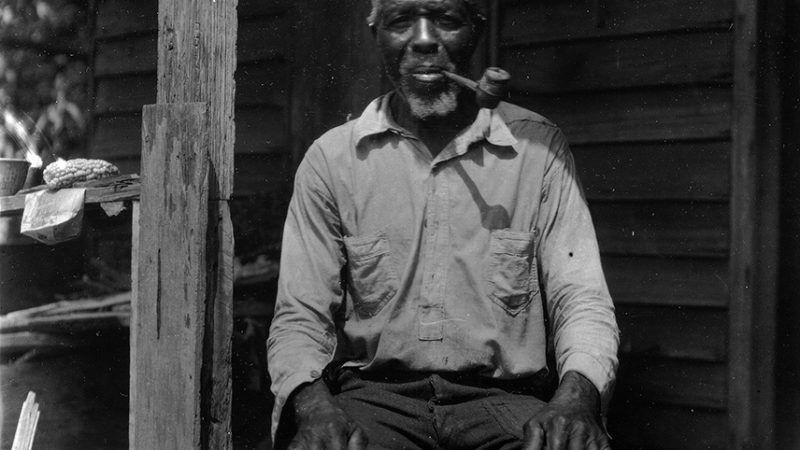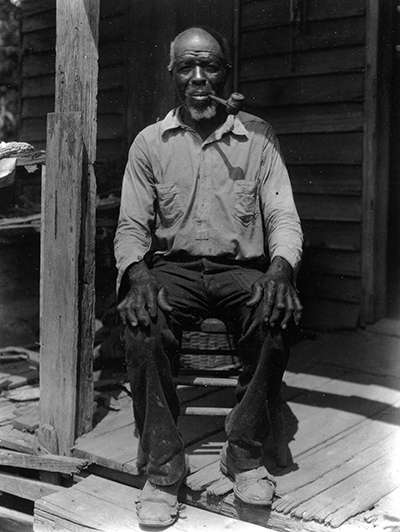Black Bodies, Radical Politics, and Rebellious Robots
Reading Zora Neale Hurston's study of the life of the last "black cargo" and watching Westworld


"Cudjo meetee de people at de gate and tellee dem, 'You see de rattlesnake in de woods?' Dey say 'Yeah.' I say 'If you bother wid him, he bite you. If you know de snake killee you why you bother wid him? Same way with my boys, you unnerstand me.'"
With these words, Cudjo Lewis—né Oluale Kossula—explains his child-rearing philosophy to an upstart anthropologist named Zora Neale Hurston in 1927. Captured by a neighboring tribe as a young adult in Africa, purchased by whites, and smuggled to U.S. soil 50 years after the Atlantic slave trade was outlawed, Lewis was freed just five years later in the wake of the Civil War and went on to have a family, found a town, and grow old in the Jim Crow era.
And at the end of his long, eventful life, a young Hurston showed up at his door hoping to glean his story. She courted him with peaches and delousing powder. He was poor and alone. She was not yet the author of that high school lit class staple, Their Eyes Were Watching God.
Barracoon: The Story of the Last "Black Cargo" is Hurston's remarkable rendition of Lewis' oral history, which she gathered over several months of visits. It is all the more remarkable for having been buried for nearly a century after its completion; the gatekeepers of the Harlem Renaissance deemed both its political and its artistic choices unacceptably heterodox. Hurston's focus on conflict between blacks as well as her anti-government espousal of black self-sufficiency sat badly with the intelligentsia of the time. It is a conflict that, tragically, is still being echoed in today's headlines and popular culture.
The phrase black bodies has recently gained currency as a way to evoke how black people have been (and still are) too often reduced to little more than their physical selves. Hurston writes that we know so little of the experience of the enslaved because "the thoughts of 'black ivory' had no market value"—a mistake she went looking to remedy before it was too late.
In Barracoon, Lewis' sense of himself as a body is palpable and modern. His heart and mind always seem to be somewhere outside of his beleaguered physical self. But he is haunted by his inability, even as a free man, to protect the bodies of his family—both his slaughtered relations in Africa and his sons in America, targeted not only for their blackness by whites but for their Africanness by other blacks. Teaching his sons to be rattlesnakes is his only choice, as far as Lewis is concerned. But it is also a fatal one. A sheriff's deputy shoots Cudjo Jr. in the throat, taking aim from behind a butcher's cart where he is cowering in response to the family's reputation as fighters.
A second son is killed by a train, but the family doesn't seek remuneration for the accident—they have already been baffled by the legal system and stiffed by a corrupt lawyer after Lewis himself was injured. Other children are imprisoned, fall victim to deadly illnesses, disappear on a fishing trip. And sorrow takes his wife, or so it seems to Lewis.
While whites play pivotal roles (none of them good, with the exception of Hurston's benefactor, who makes an awkward cameo in the tale), the violence done to Lewis and his family is most often at the hands of other blacks—the Africans who enslaved him, the American blacks who taunt his children as savages, and finally the sheriff's deputy who kills his son and namesake. Lewis muses "he say he da law, but he doan come 'rest him. If my boy done something wrong, it his place to come 'rest him lak a man." But it's an idle thought; he has long since abandoned the illusion that institutions he didn't build with his own hands will do right by him.
Hurston was raised in the all-black town of Eatonville, Florida; her early life and education were the product of a radical experiment in black autonomy. Her politics were iconoclastic, combining individualism, anti-interventionism (she famously called Harry Truman "the Butcher of Asia" for his use of the atom bomb), and vehement opposition to not just the New Deal but Brown v. Board of Education, on the grounds that government intervention in the lives of blacks was dangerous and dependency-creating.
In Barracoon, Lewis' story is both a primitivist cliché and a moving, highly idiosyncratic personal tale with a mostly unhappy ending. That combination troubled Hurston's more progressive peers, such as Langston Hughes. Lewis' speech is captured in dialect as part of Hurston's anthropological mandate to record a vanishing form of speech and way of life, but the transcription is not obscured by jargon or technical notation—it's rendered in a readable phonetic form. Lewis is pious in the simplest manner, apparently buying into the idea that a major upside of his enslavement was the soul-saving and civilizing influence of the church in his life. Hurston brings him watermelon, which he loves, as a bribe to keep him talking.
The subtle sophistication of the presentation, especially the self-awareness in the choice to offer the story as a seemingly unpolished oral history set within a matryoshka doll of scholarship, elevates it from the caricatured to the profound. Barracoon is an anthropological study nestled inside the author's own notes and speculations, which in turn is wrapped in a modern-day editor's layer of prefaces and addenda, surrounded by a poetic miasma created by Alice Walker. It was Walker who revived Hurston's reputation with a 1975 Ms. magazine article, published after she discovered Hurston too had died alone and impoverished, reduced to working as a maid, and was buried in a pauper's grave.
After I finished reading Barracoon—which is short enough to be consumed in a single session—I caught up on Westworld, the new prestige HBO drama set in a playground for the rich staffed by humanoid robotic "hosts." Over and over, the viewer is shown heaps of decommissioned robots that have been raped, shot, run over, or otherwise broken for the amusement of humans who feel free to let loose their darker impulses on the grounds that the victims aren't "real." They're just bodies, after all. Infinitely replaceable, totally biddable bodies.
But a sophisticated humanoid robot is the 21st century equivalent of Chekhov's gun—as soon as one appears on the scene, we must prepare for the moment when it becomes sentient and then vociferously objects to its previous treatment at the hands of its careless owners.
In Westworld, we're tempted to root for the robots, many of whom have an appealing messianic zeal about their own individuality and autonomy—especially one robot with a rattlesnake tattoo and an itchy trigger finger. "These violent delights have violent ends," the bots repeat as a vengeful mantra, as they fight their way out of bondage and toward a dream of freedom.
Any comparison between real black history and robot science fiction is fraught, but the Westworld robots' rebellion is clearly modeled after the many rights revolutions of the 19th and 20th centuries. The tale of the righteous robot uprising feels comfortably familiar, even inevitable. But Westworld is still unfinished and looks to be heading for an unsatisfying conclusion, not unlike its real-world source material.
What makes Barracoon so striking is that Lewis sits at a perfect intersection between the slave trade and Jim Crow, between Africa and America, between life and death. He is precisely the sort of character who, in fiction, would act as an agent of social change. But his arc doesn't follow such narrative demands, and his story ends in a murky twilight.
A century and a half after slavery was abolished, it's still infuriatingly hard to reconcile the obvious truth of black humanity with the messy reality of political and cultural change. The difficulty of navigating that tricky path ultimately felled Cudjo Lewis, his sons—and Hurston herself. Whether their successors can do better remains to be seen.
This article originally appeared in print under the headline "Black Bodies, Radical Politics, and Rebellious Robots."


Show Comments (44)